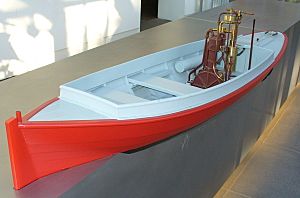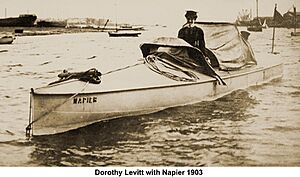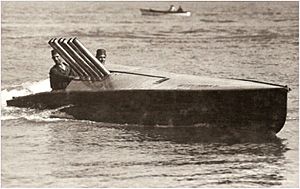Motorboat facts for kids
A motorboat is a special kind of boat that uses an engine, also called a motor, to move through the water. Imagine a boat that doesn't need sails or oars – that's a motorboat! Some motorboats have their engines built inside the boat, which are called inboard engines. Others have an engine attached to the back, outside the boat, known as an outboard motor. This outboard unit usually has the engine, gears, and propeller all in one handy package.
There are also boats with a mix of both: the engine is inside, but the gears and propeller are outside. This is called an inboard/outboard system.
Contents
How Motorboats Began
The First Engines on Water
People started putting screw propellers on engines way back in the 1700s. But boats powered by a petrol engine (like the fuel cars use) only appeared much later, in the late 1800s. This happened after the invention of the internal combustion engine, which is the type of engine that burns fuel inside to create power.
The very first boat to run on a petrol engine was tested in 1886 by two clever inventors, Gottlieb Daimler and Wilhelm Maybach. They tried out their new engine, which they called a "longcase clock" engine, on the Neckar River in Germany. Their first boat had a single cylinder engine with just 1 horsepower! A year later, in 1887, Daimler made a second boat with a "V-type" engine, which had two cylinders.
Early Motorboat Makers
The first really successful motorboat was designed by the Priestman Brothers in England, led by William Dent Priestman. They started testing their motorboat in 1888. Their engine used kerosene fuel and had a new high-voltage ignition system to start it. The Priestman Brothers were the first to start making motorboats in large numbers. By 1890, their boats were already being used to pull goods along canals!
Another early inventor, Mr. J. D. Roots, used a motorboat to run a ferry service on the River Thames in London in 1891 and 1892.
The famous inventor Frederick W. Lanchester also saw how useful motorboats could be. For 15 years, he worked with his brother George to make modern motorboats even better. In 1893, they built a flat-bottomed river boat with a fast engine that powered a paddle wheel at the back. Later, in 1897, he made another engine that ran on benzene and could turn a propeller both forwards and backwards. A very important part of his new engine was the carburettor, which mixes fuel and air perfectly. He patented his special "wick carburetor" in 1905.
The Daimler Company started making motorboats in 1897. Their early engines had two cylinders and used a heated platinum tube to ignite the fuel. These engines produced about six horsepower. It wasn't until 1901 that a safer way to ignite the fuel with an electric spark was used in motorboats.
Motorboats Become Popular
Interest in fast motorboats grew very quickly in the early 1900s. In 1903, the Marine Motor Association was created to focus on motorboating. A magazine called Motor Boat & Yachting started in 1904, sharing new ideas and designs. Big companies like Napier & Son and Thornycroft also began building motorboats.
The first big motorboat race was started by Alfred Charles William Harmsworth in 1903. This race, called the Harmsworth Cup, was meant to be a competition between different countries, not just individual boats or drivers.
The first Harmsworth Cup race happened in July 1903 in Ireland. Many boats couldn't even start! The race was won by Dorothy Levitt in a Napier boat. This boat was the first one truly designed for high speed. Dorothy Levitt set the world's first water speed record, reaching about 19.3 miles per hour (31 km/h) in her 40-foot steel boat with a 75-horsepower engine. After her win, King Edward VII congratulated her on her bravery and skill.
France won the race in 1904. In 1905, the boat Napier II set a new world water speed record, reaching almost 30 knots (56 km/h)!
In America, a brilliant boat designer named John L. Hacker changed how boats were built. He invented the V-hull shape and used special petrol engines. In 1908, he started the Hacker Boat Co. In 1911, Hacker designed the Kitty Hawk, which was the first successful "step hydroplane". This boat went over 50 miles per hour (80 km/h), which was incredibly fast back then, making it the fastest boat in the world! Americans first won the Harmsworth Cup in 1907. From 1920 to 1933, an American named Gar Wood had an amazing winning streak, winning the race eight times as a driver and nine times as an owner.
How Motorboats Work
A motorboat can have one or more engines that push it across the water. These engines come in many shapes, sizes, and types. As we learned, engines can be inboard (inside the boat) or outboard (attached to the back). Inboard engines are built right into the boat's structure. Outboard engines are secured to the back, called the transom, and hang off the boat.
Motorboat engines usually run on gasoline or diesel fuel. There are also other types of engines, like gas turbines, rotary combustion engines, or even steam engines.
What Motorboats are Used For
Motorboats are often used for fun activities like recreation or for exciting races. Boat racing is a sport where drivers and engineers compete to see who has the fastest boat. The American Powerboat Association (APBA) divides the sport into different groups. These groups include races for inboard engines, outboard engines, and even offshore races. Boats are also grouped by their hull shape.
The two main types of hull shapes are runabout and hydroplane. A runabout hull is V-shaped, while a hydroplane hull is flat and has steps. The best hull shape depends on the type of water the boat will be in and how it will be used. Hulls can be made from wood, fiberglass, or metal, but most modern hulls are made of fiberglass.
Some high-performance speedboats can go over 50 knots (about 93 km/h)! Their incredible speed comes from their special hull designs and very powerful engines. A powerful engine needs the right hull shape to work best. Examples of high-performance boats include yachts, high-speed interceptor craft (HSIC), and racing powerboats.
A V-shaped hull helps a boat cut through the water smoothly. A deep V-hull helps keep the front of the boat down at slower speeds, which makes it easier to see where you're going. V-hulls also help boats go faster and turn better. They also make the boat more stable in rough water.
Images for kids
-
A motorboat with an outboard motor.
See also
 In Spanish: Lancha motora para niños
In Spanish: Lancha motora para niños











